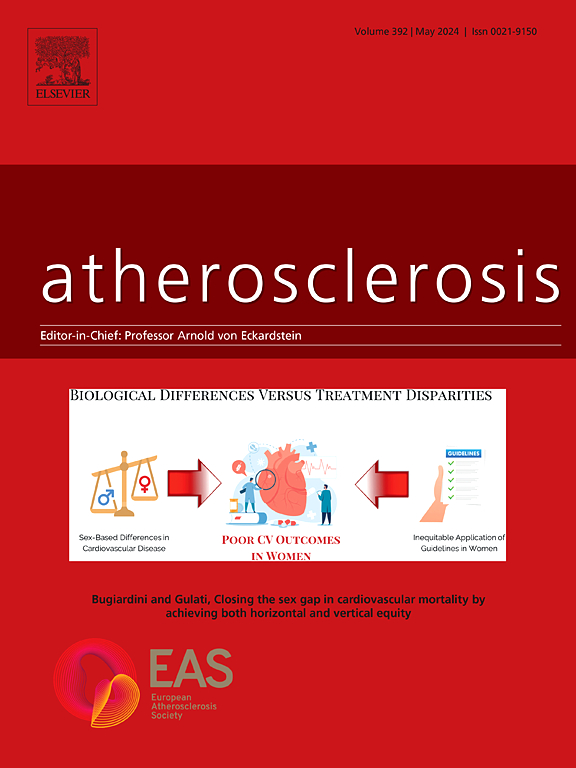Prior exposure to doxorubicin exacerbates atherosclerotic plaque formation in apolipoprotein-E-deficient mice on a high-fat diet
IF 5.7
2区 医学
Q1 CARDIAC & CARDIOVASCULAR SYSTEMS
引用次数: 0
Abstract
Background and aims
Epidemiological data suggest that anthracyclines, such as doxorubicin (DOX), promote atherosclerosis in cancer survivors. However, this has not been established experimentally so far. Here, we investigated whether DOX pre-exposure exacerbates atherosclerotic plaque formation (Study 1) as well as the impact of DOX on plaque progression (Study 2). Further, we evaluated the role of alpha-1-antichymotrypsin (Serpina3n) and thrombospondin-1 (Thbs1) in these plaques as we previously identified these proteins to be associated with DOX-induced cardiovascular disease.
Methods
In Study 1, DOX (4 mg/kg body weight/week) was administered for three weeks to apolipoprotein-E-deficient mice followed by a high-fat plaque-promoting diet for 8 weeks. In Study 2, mice were fed a high-fat diet for 17 weeks with DOX administered concomitantly from the third week of diet for three weeks. Plaque size and composition were assessed in the thoracic aorta, brachiocephalic artery and proximal ascending aorta.
Results
Prior DOX exposure increased plaque size along the aortic tree, regardless of sex. This was accompanied by enhanced cell death (increased TUNEL positivity) as well as elevated Serpina3n and Thbs1 in plaques of DOX-treated mice. DOX did not change total cholesterol, HDL and LDL plasma concentrations. Conversely, concomitant DOX exposure did not enhance plaque size nor affect overall plaque composition along the aortic tree, highlighting the importance of experimental design.
Conclusions
Early DOX exposure exacerbated plaque development in mice, providing first experimental evidence for anthracycline chemotherapy as a possible risk factor for atherosclerosis in cancer patients.

先前暴露于阿霉素会加剧高脂肪饮食中载脂蛋白e缺乏小鼠的动脉粥样硬化斑块形成
背景和目的流行病学数据表明,蒽环类药物,如阿霉素(DOX),可促进癌症幸存者动脉粥样硬化。然而,到目前为止,这还没有在实验中得到证实。在这里,我们研究了DOX预暴露是否会加剧动脉粥样硬化斑块的形成(研究1)以及DOX对斑块进展的影响(研究2)。此外,我们评估了α -1-抗凝乳胰蛋白酶(Serpina3n)和血栓反应蛋白-1 (Thbs1)在这些斑块中的作用,因为我们之前发现这些蛋白与DOX诱导的心血管疾病相关。方法在研究1中,载脂蛋白e缺乏小鼠连续3周给予DOX (4 mg/kg体重/周),随后给予高脂促进斑块饮食8周。在研究2中,小鼠被喂食高脂肪饮食17周,并在第三周的饮食中同时给予DOX,持续3周。评估胸主动脉、头臂动脉和近段升主动脉斑块的大小和组成。结果先前的DOX暴露增加了沿主动脉树斑块的大小,不分性别。这伴随着增强的细胞死亡(增加TUNEL阳性)以及在dox处理的小鼠斑块中升高的Serpina3n和Thbs1。DOX没有改变总胆固醇、HDL和LDL的血浆浓度。相反,同时暴露于DOX不会增加斑块大小,也不会影响沿主动脉树的整体斑块组成,这突出了实验设计的重要性。结论早期DOX暴露会加剧小鼠斑块的形成,为蒽环类药物化疗可能是癌症患者动脉粥样硬化的危险因素提供了第一个实验证据。
本文章由计算机程序翻译,如有差异,请以英文原文为准。
求助全文
约1分钟内获得全文
求助全文
来源期刊

Atherosclerosis
医学-外周血管病
CiteScore
9.80
自引率
3.80%
发文量
1269
审稿时长
36 days
期刊介绍:
Atherosclerosis has an open access mirror journal Atherosclerosis: X, sharing the same aims and scope, editorial team, submission system and rigorous peer review.
Atherosclerosis brings together, from all sources, papers concerned with investigation on atherosclerosis, its risk factors and clinical manifestations. Atherosclerosis covers basic and translational, clinical and population research approaches to arterial and vascular biology and disease, as well as their risk factors including: disturbances of lipid and lipoprotein metabolism, diabetes and hypertension, thrombosis, and inflammation. The Editors are interested in original or review papers dealing with the pathogenesis, environmental, genetic and epigenetic basis, diagnosis or treatment of atherosclerosis and related diseases as well as their risk factors.
 求助内容:
求助内容: 应助结果提醒方式:
应助结果提醒方式:


